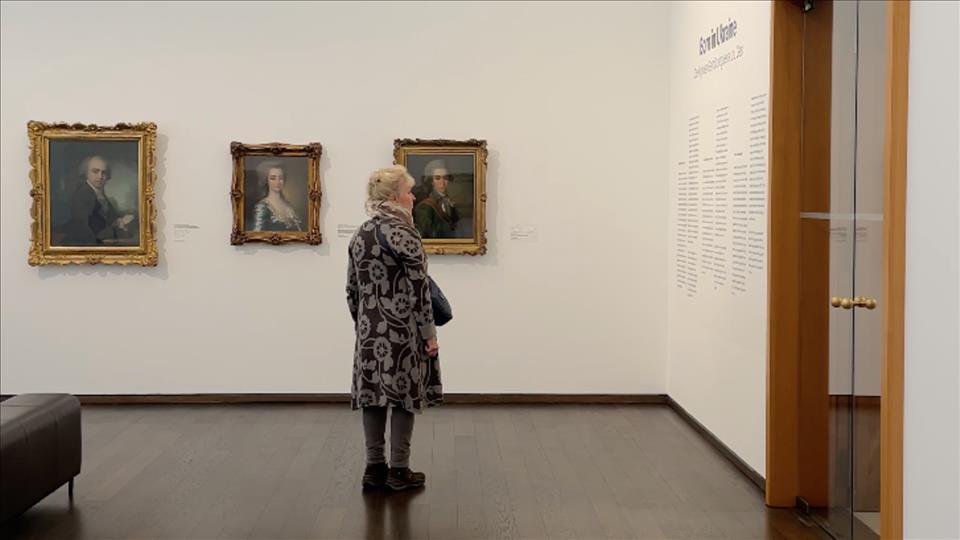(MENAFN- Swissinfo) The Kunstmuseum Basel has tweaked its programme to welcome 49 paintings brought out of Ukraine. The exhibition was organised in collaboration with the Kyiv Picture Gallery and will be open until April 30.
This content was published on December 20, 2022 - 14:00 December 20, 2022 - 14:00 Céline joined swissinfo.ch in 2018 as video journalist for the 'Nouvo in English' project, just after graduating from the Academie du journalisme et des medias (AJM) at the University of Neuchâtel. Originally from Ticino, she's been filming, writing and interviewing people all over Switzerland since she got her first reporter badge at 11 during a school camp.
more from this author | multimedia A handful of visitors quietly pace through the rooms on the ground floor of the Hauptbau building of the Kunstmuseum Basel. Since the beginning of December, the spaces have been filled with artworks belonging to the Kyiv Picture Gallery.
'Most of the works that we present in this exhibition are part of the permanent collection in Kyiv,' explains Olga Osadtschy, one of the three curators behind the project. 'So they hang in the Tereshchenko palace in the center of the city, a beautiful old villa. The spaces are very small and it's a historical interior. So to see the works of art in our building here from the thirties, was quite interesting.'
The largest part of the collection, made of 40,000 works, has remained in Kyiv.
'When the war broke out, all the colleagues from the museum in Kyiv packed the works and tried to close the windows to bring as much security as possible to the building,' said Osadtschy. The national gallery's director started looking for partners to evacuate some of their artworks and were helped by the International Council of Museums (ICOM) who connected them to art institutions in Switzerland. The Musée Rath in Geneva is also exhibiting worksexternal link from the same Ukrainian museum.
Meaningful gestureDiscussions on how to support their Ukrainian colleagues were already underway at the Kunstmuseum Basel when they heard from the National Art Museum in Kyiv.
'We had no previous contact with this museum, so it was a big adventure in a way. But then we realised this could be a really meaningful gesture, and started to work on it,' said Josef Helfenstein, the director of the Kunstmuseum in Basel. 'We had no budget for it, our programme was fixed, finished. So we had to decide where can we do this, if we can do it, and so on. We decided that it would be in these spaces, and that we would postpone another project.'
Just days before the paintings were due to leave the Ukrainian capital, a bomb exploded next to the museum building, damaging it. The artworks remained untouched.
'Despite this, the situation in Kyiv is much easier compared to the situations of museums in Kharkiv or in places that are closer to the front,' explains Osadtschy. 'The museum in Kherson for example was completely emptied by the Russian army.'
As the curator explains, Ukrainian cultural heritage has been a target since the beginning of the war. On November 24, ICOM issued an emergency red listexternal link compiled with 11 Ukrainian museums, to identify cultural heritage at risk and to help intercept illicit trade of looted artworks.
Financial support from the governmentEntry to the exhibition at the Kunstmuseum Basel is free of charge. It's an invitation to regular visitors to discover the art from eastern Europe, but also to Ukrainian refugees who fled to Switzerland.
'I think there is a European- or a Swiss-wide consensus that refugees from this war should have free entry to museums,' said Helfenstein.
'We think that rather than sending money to Kyiv - which would be rather complicated because we're just a partially private institution - it's more important for us to be a platform or a place where the art from their [the National Gallery's] collection can be shown and teach us by giving us more insight into [eastern European art] about which we don't have enough knowledge.'
The project was financially supported by the Federal Office of Culture. The Swiss government body has 'the possibility to grant financial assistance to the benefit of maintaining cultural heritage of other State' explains Tania Esposito Hohler, from the Department of International Cultural Property Transfer.
'Since March the Federal Office of Culture put out a special call for projects aiming at protecting and maintaining movable Ukrainian heritage. So far we've supported 11 projects for a total of almost CHF400,000. The large number of supported projects concerned the supply of protective materials for roughly 100 museums in Ukraine: fire extinguishers, packaging material and so on.'
The Kyiv National Gallery is looking for other venues in Europe who could host the exhibition after April 30 in case the paintings could not be repatriated to Ukraine.
More
More
anti-semitism in switzerland
anti-semitic prejudices tend to rise to the surface during crises. switzerland has a history of this kind of discrimination.




















Comments
No comment